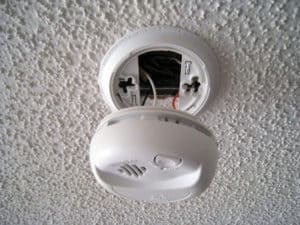This Saturday, July 15, marks National Pet Fire Safety Day in the United States. The National Fire Protection Association reports that household pets are responsible for over 1,000 house fires in the US each year and at least 40,000 pets die each year in house fires.
So how you can keep your pets – and your family – safe from fire? Here are a few tips.
If you’re leaving home for more than a few minutes, remove stove knobs. Pets are notorious for touching things they shouldn’t. Once you’re out of sight, their curious side really comes out. This can be incredibly dangerous when it comes to stove knobs. They can touch the knob, turning the stove on, and then walk across a glass-top stove not realizing it’s on. Or worse, if you’ve left an item on the stove – it can immediately start a fire and spread quickly.
Here’s an example of what happened when a Labrador was interested in pizza on a gas stove. Fortunately his owners were home and able to quickly put out the fire.
Don’t leave candles unsupervised. The flicker of a candle can be mesmerizing for pets, especially cats. They will often go to swat at it and once the heat scares them – the candle can become knocked over as they run away.
Don’t leave a space heater unattended. During cold winter months, pets like to be in places where it’s warm (just like us!). It’s incredibly important to not leave one on unattended. A pet can lay next to one and their hair can catch on fire. Or they can knock items in front of the space heater which become enflamed.
Be sure smoke detectors have fresh batteries. According to the U.S. Fire Administration, smoke detectors should be tested at least once a month and batteries should be replaced at least twice a year. Most dectectors have a button you can push to do a manual test. It’s very simple and won’t take more than a few seconds. Check your owner’s manual for instructions. Making sure your batteries are in working order means if there is a fire in your home – you’ll be alerted quickly.
Make a rescue plan. And by “make a plan” – we mean a literal plan. Draw a diagram of you home and know the escape routes. How will you get your dog out of the house? What’s the best way to transport your cat? Or birds? Or other pets? Think all of this through so you’re not having to try to figure this out in the moment. Share it with all family members so they know the plan of action and can take charge if they are closer in proximity to a certain pet at the time the fire breaks out.
Have an emergency kit ready to go. Keep a pet emergency kit in your car should you need to evacuate your home. Keep anything non-perishable (water, box of bones or treats, familiar toys, spare pet bed). Also, be sure to have the name/phone number of your vet stored in your phone as well as the name/number of the local emergency after-hours clinic should you need them.
Hopefully these tips will help get you started as you think about pet fire safety. Our pets are family and their safety is our top priority!
